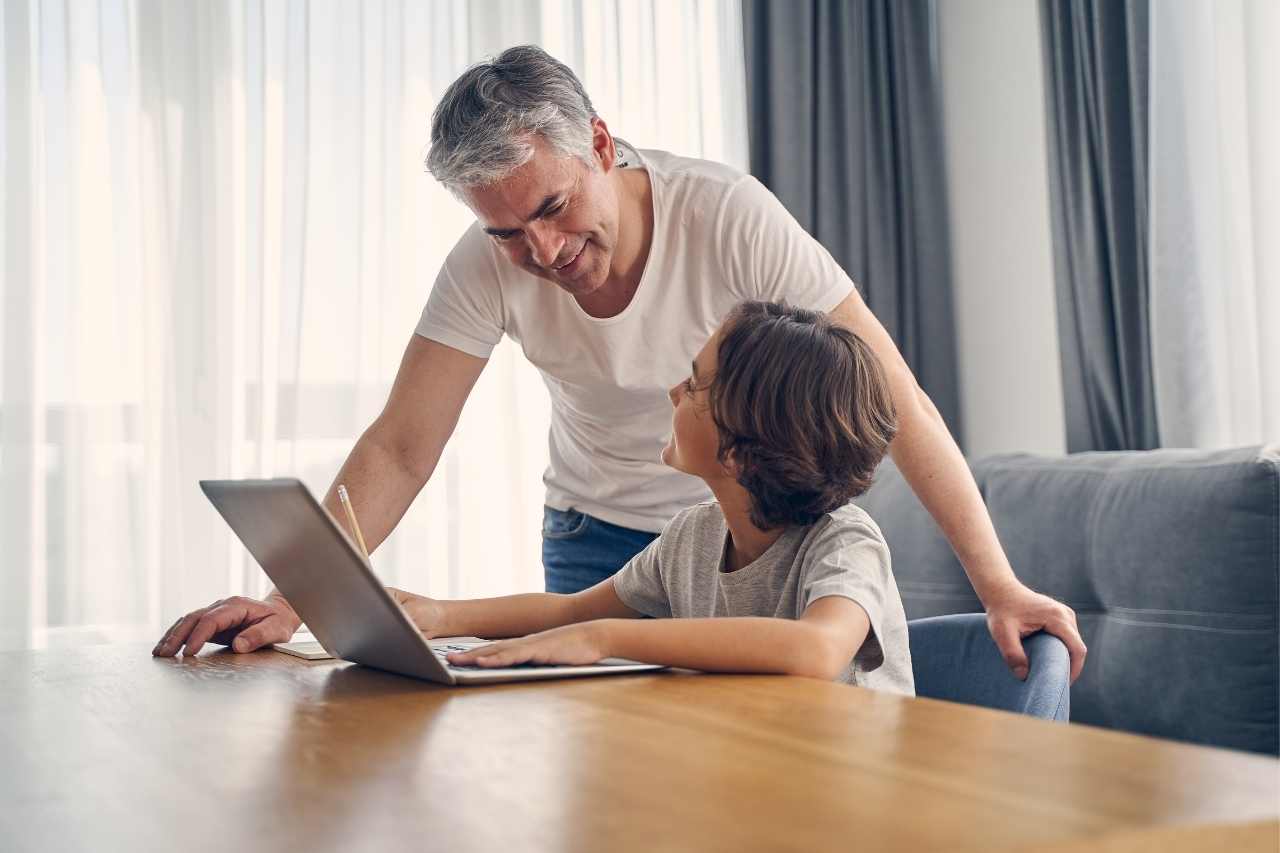It’s probably the furthest thing from our minds, as parents, to consider our children viewing pornography and having to have a conversation about it. But worry not, this article is here to help you with how you can talk to your children about pornography.
Unfortunately, things have changed since we were children. It was a totally different time when it came to pornography. Something that had to be deliberately searched out, rather than something that appeared on one’s iPad by accident.
It seemed improbable that a child would be exposed to pornographic material, whether by accident or design.
All of us, sooner rather than later, must engage in “porn discussion” in today’s day and age. Despite our best efforts, our children may still come into contact with pornographic material, and this risk rises as they get older and may go out of their way to seek it out on their own.
However difficult, this talk must not be excruciatingly painful or terrible. Let’s speak about how to talk to your children about pornography in a healthy and beneficial way.
Is My Child’s Exposure to Pornography Real?
You’re certain that your youngster will never come into contact with any pornographic material. After all, you’ve installed parental controls on their digital gadgets and keep an eye on them like a hawk.
The likelihood that your child will come into contact with pornographic material (such as videos or photographs) increases exponentially as they approach adolescence.
Even the strongest digital parental controls cannot always filter out pornography, which is so common on the internet. Pornographic websites may appear on your child’s browser if they enter a URL incorrectly. There is a chance that they will receive unintentional text or video communication. Pornography can easily become a part of your child’s social circle as they get older and become more interested in sex.
In the same manner, your child isn’t always in your care. While visiting another child’s room, they may come upon pornography. Depending on your child’s age, they may come across pornographic material that has been passed down via a friend, an older sibling, or even through their own research and curiosity.
Children should be aware that while sexual exploration is perfectly acceptable, the sex represented in pornography is not and frequently depicts unhealthy forms of sexual expression.
So What’s the Purpose of the “Porn Talk?”
Teens, tweens, and children are engaging in unprecedented levels of online media consumption and socialization.
It’s possible that some of our children’s teachers will discuss pornography in class (for example, a health teacher), but that’s not a given. Nowadays, parents everywhere must have the “pornography conversation,” just as it is our duty to have the “sex talk” with our children.
In the end, we can’t avoid the fact that our children will be exposed to pornography at some point in their lives. As a result, having a “safe” person with whom to share their thoughts, anxieties, and confusion is essential.
Pornographic depictions of sex should be discussed with our children so they can distinguish between them and what actual sex might be like in the future. We must teach them the proper techniques for having sex in a safe and responsible manner.
If we don’t intervene, our children will be left feeling isolated when presented with disturbing pictures of sex.
Talking to Your Children About Pornography: Some Ideas for Discussion
Knowing that you will have to have a conversation with your children about pornography can be stressful, but having some “talking points” in mind can be incredibly helpful. Make sure to keep in mind that there is no one “correct” method to do things. Approaching the topic in a way that both you and your child are comfortable with is the best way to do it.
Children under the age of ten.
In most cases, it isn’t necessary to go into great depth regarding pornography with younger children. However, you should bring up the possibility of their seeing pornography when talking about sex in general. Even yet, it isn’t necessary to go into great detail during these exchanges.
When discussing sex and pornography with children, here are some things to keep in mind:
Re-establish Healthy Relationships.
Hugging and physical intimacy are both pleasurable for youngsters. To put it another way, sexual activity involving two consenting adults is just a logical extension of that idea. Your youngster will have a better understanding of sex if you do this.
Discuss Sex in a Clear and Uncomplicated Manner.
The first time you discuss sexual activity with a young child, be sure to use the correct names for body parts (“penis” and “vagina”) and explain what sexual contact and sexual encounters entail. They may be surprised or disgusted by the situation. Answer their queries truthfully and help them understand that they are not alone in this.
Educate them about what they can encounter while surfing the Internet.
You don’t have to go to great lengths about pornography with young children. As a result, you and your children need to be aware that adults may post explicit photographs of sex on the internet, which youngsters may view. Some of these photos may cause a reaction in children.
Your children must understand that they may come to you if they see images of pornography and that they will not be punished if they do.
Share Age-Approved Sex Information.
This isn’t something that you have to handle on your own. It’s important to select books about sex that your child can relate to, with a tone that they find helpful and reassuring, before introducing them to sex education.
For children in middle school and older.
It is likely that your child will come across pornography as they approach puberty, either by accident, on their own, or because a friend has shared it with them. Discussing pornography with your child is never too late to begin, so long as you’ve not already started. To get around this, follow these steps:
Consider a “Low-Stakes” Date.
After supper is probably not the best time to sit down and talk seriously with your tween or adolescent. A conversation that is more “casual” is preferable. In the automobile, on a walk or hike, or late at night, when kids are most likely to be open to casual talks, you might want to try conversing with your teen without forcing them to look you directly in the eyes.
Set Up a No-Judgement Zone in Your Workspace.
Your youngster must know there will be no judgment. You are not accusing them of viewing pornography, nor are you threatening them with punishment if they are found guilty of it in the future. Your tween or adolescent is unlikely to engage in a conversation with you if you set things up in a punishing or judgmental manner.
Open-Ended Questions.
As long as you don’t let them assume they know it all, tweens and adolescents are fine with it. A list of facts isn’t going to help, and neither is asking too many probing questions. When you can, let them lead the conversation.
Talk About It Constantly.
Any discussion about sex, including the “pornography discourse,” should be ongoing. Pornography can be a sensitive subject for children for a long time, so it’s best to have multiple, brief discussions with your child about it over time.
Pornography versus Real Sex.
It’s critical that you explain the differences between pornography and real-life sex to your tween or teen when you bring up the subject of pornography. Otherwise, they may have unrealistic expectations for their first sexual experiences.
Make sure they understand that pornography is fiction, that bodies are frequently altered for entertainment, that pornography is made to look a specific way, and that what they are witnessing is not a private experience but a curated one.
Consent and personal boundaries are important topics to bring up during this conversation.
Nonconsensual sex may be depicted in pornography, which may entail violence or rape. Real-life situations like these are never acceptable, and your child must understand this.
Discuss the need for specific and enthusiastic permission during sex, as well as the importance of respecting your sex partner’s desires and well-being.
Sexual arousal should be normalized.
You must let your youngster know that it’s natural to have a good reaction to pornography throughout your conversation about it. When teenagers are exposed to sex or sexual images, they are more likely to get sexually aroused.
If you make your children feel bad about their feelings, they’ll be less open to talking about other aspects of pornography in the future.
Include the “Safe Sex” Discussion if possible.
Most pornographic images do not feature condoms or other methods of pregnancy prevention. Use this as a starting point to talk to your child about ways to keep sex safe, such as preventing sexually transmitted diseases and unplanned pregnancies.
Having “the birds and the bees” discussion with our child is something most of us expect to do, but we may be surprised to learn that we also need to have “the pornography chat” with our child.
Despite our best efforts, this is a fact of life that we can’t avoid. Whether we like it or not, our children will come into contact with pornography at some time in their life. As parents, it is our responsibility to talk to them about it in a way that is both healthy and informative.
However, we don’t have to do this all on our own. We live in troubling times, but as parents, we have more power than we realize to provide our children with the information, safety, and support they need to navigate these new waters.
Meaningful articles you might like: What to Do if You Discover Porn in Your Teen’s Web History, Questions Can You Ask Your Teen To Help You Connect, 6 Solutions To Your Kids and Teens Screen Time Woes

